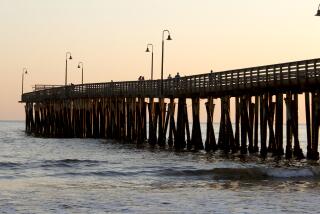In Hail of Gunfire, Trouble Comes to Paradise
SANTA CRUZ HUATULCO, Mexico — To Sam Garrett, 26, a newlywed from Seattle, the first sign that something was wrong came Friday morning when he flew into the airport at this Pacific beach resort. Instead of finding sunburned tourists, he ran smack into grim-faced soldiers.
“They were standing all over the place with their machine guns,” he said as he sunned himself by a hotel pool with his new bride, Erin. “They were everywhere this morning . . . checking everything.”
A day after little-known left-wing rebels shocked Mexico with a series of attacks--two of them at popular tourist sites--the town that guidebooks call “Mexico’s newest and hottest resort” was struggling to put on a normal face: City workers daubed over guerrilla slogans that had been scrawled in the town square during the attacks. Investigators were counting the bullet holes at the police station.
But as the army presence here showed, trouble had arrived in paradise. Like many other Mexicans, dazed Huatulcans wondered if their lives and Mexico’s $6-billion tourism industry could be threatened by a rebel movement that appeared better armed and more persistent than any that had appeared in decades.
“We’re very afraid,” said Nicolasa Garzon, a waitress at a restaurant on the town square, where attackers appeared firing Soviet-made rifles around midnight Wednesday. The masked rebels targeted police and military posts near the square, leaving 10 dead.
“This was a tranquil town,” Garzon said with a sigh. “Maybe it won’t be the same.”
*
Santa Cruz Huatulco was one of half a dozen towns across southern Mexico where rebels struck at security forces late Wednesday and early Thursday, in apparently coordinated attacks that left at least 14 dead and more than 20 wounded. The surprise assaults occurred just as President Ernesto Zedillo sought to show the world that Mexico was recovering from its worst political and economic turmoil in decades.
While the rebels who launched the deadly assaults--said to be members of the left-wing Popular Revolutionary Army--called for the downfall of Zedillo’s government, Huatulcans interviewed appeared to have little sympathy for them or their cause.
An upscale resort that draws 150,000 tourists a year to pristine beaches and a turquoise sea, Huatulco is a new star in Mexico’s all-important tourism business, the country’s third-biggest source of foreign exchange.
Once an isolated wilderness, Huatulco was chosen by the government in the 1980s for a major tourism development. With a giant Club Med resort, luxury hotels and the popular town square--a Disney-esque re-creation of a Mexican colonial plaza, edged with restaurants--it has drawn workers from around Mexico.
“All the shops, the restaurants--we live off tourism,” said Yesnec Zamora, receptionist at Hotel Flamboyant on the main square.
Patricia Reyes, a single mother who sells flan on the beach, asked, “If the foreigners don’t come, how will we survive?”
But as of Friday, the tourism industry appeared largely unaffected. No vacationers were killed in the attack here or in the older beach resort of Acapulco. Hotel owners here said they hadn’t received many cancellations.
*
In Southern California, a major departure point for Acapulco and Huatulco and one of the main contributors to tourism in southern Mexico, the attacks also appeared to have had little initial effect. Southland offices of Aeromexico and Mexicana Airlines, Mexico’s two largest air carriers, reported negligible customer reaction.
“We haven’t had any impact in our loads to Acapulco,” said Aeromexico sales manager Carlos Gutierrez. “We haven’t gotten any calls at all.”
But it simply may be that many tourists have yet to hear just how close the attacks occurred to tourist areas; the firefights here, for example, erupted a mere five miles away from resort areas.
Claire Barber, 53, of Tulsa, Okla., who was lying poolside Friday at the Sheraton Hotel, said she had only heard rumors of the violence. But she said she was surprised when, returning from dinner in the town square Thursday night, a police car suddenly materialized to accompany her.
“We just assume the government is paying attention to the tourist areas,” her friend Margaret McDermott, 55, of Austin, Texas, said from her adjoining chaise.
Richard Delaney, the Sheraton manager, also was unconcerned, saying, “It wasn’t anything geared toward tourism or the population.”
One sight that doubtless would worry any tourist was the handful of armored personnel carriers crawling through Huatulco streets Friday. The vehicles were topped with machine guns manned by wary soldiers.
Soldiers who flooded the town after the attacks had largely left but were reported combing the hills around Huatulco for rebels.
In town, residents said they were troubled, wondering if anyone they know was involved in the attack. While most said they had not heard of guerrilla violence in this state, Oaxaca, they were impressed by the way these rebels had found their targets in Huatulco, attacked them, then fled.
“They planned it for a long time,” said Benito Ramon Santos, the local police commander whose station came under fire late Wednesday, costing the lives of two of his men. “They knew how many we were, where we slept, when we went to eat. They knew that not only about us but about other official offices” that were attacked. The rebels appeared to have military training and plenty of ammunition, he added.
Jose Luis Fernandez, a city worker, was painting over the rebel slogans that had been spray-painted on the heavy white benches in Huatulco’s faux-colonial square. He disagreed with the group’s violent methods. But some people sympathize with the rebels, he said, adding, “Like anywhere, the rich are in one area, the poverty is hidden away in another.”
Times staff writer Nancy Rivera-Brooks in Los Angeles contributed to this report.
More to Read
Sign up for Essential California
The most important California stories and recommendations in your inbox every morning.
You may occasionally receive promotional content from the Los Angeles Times.










